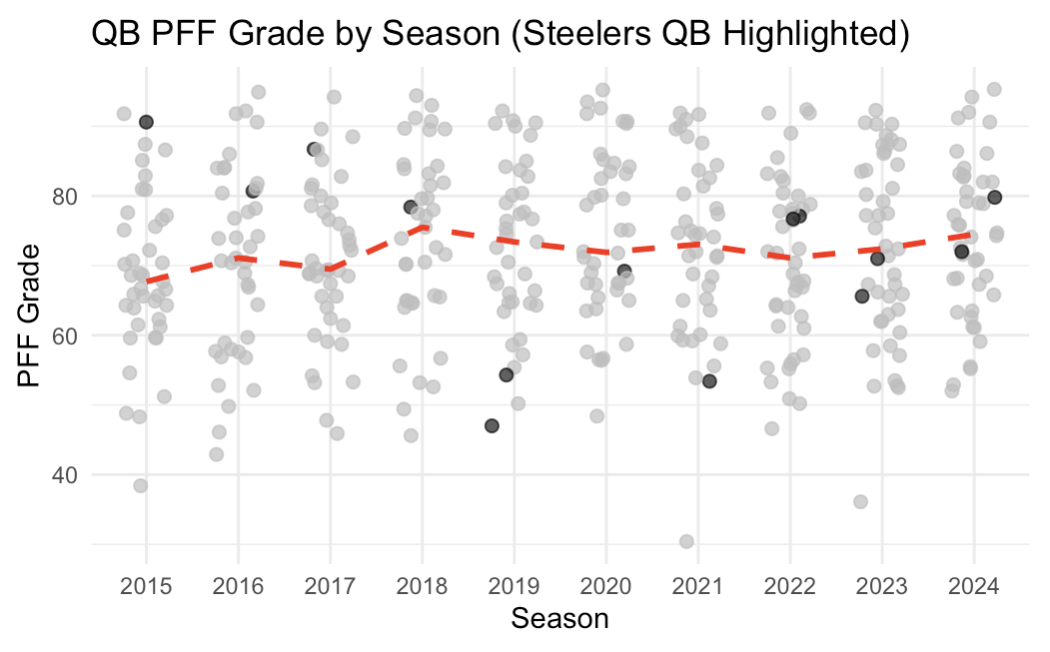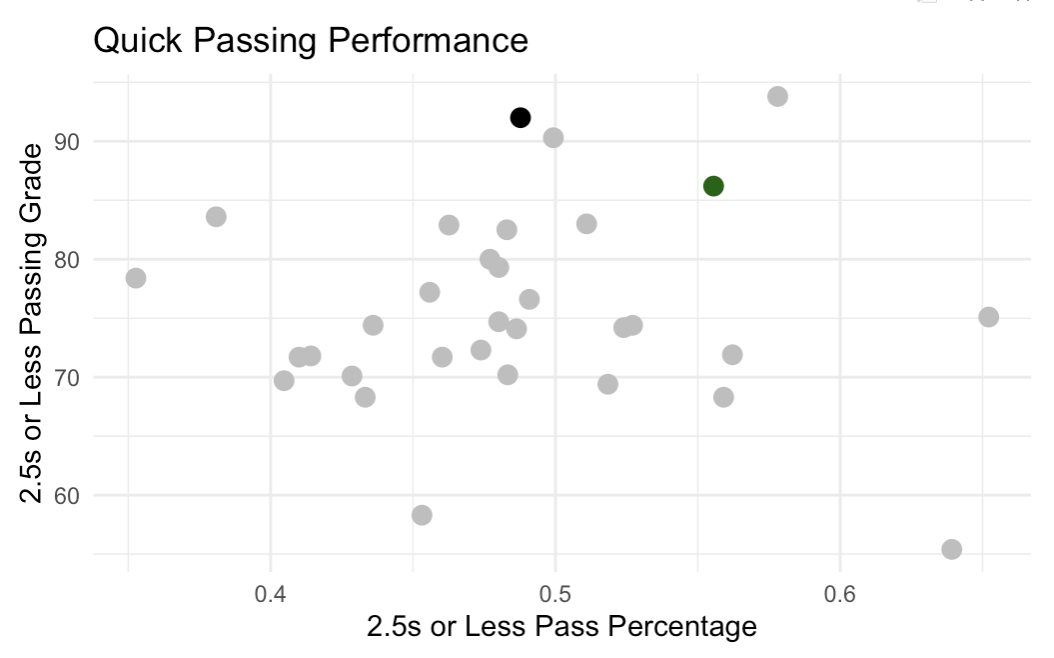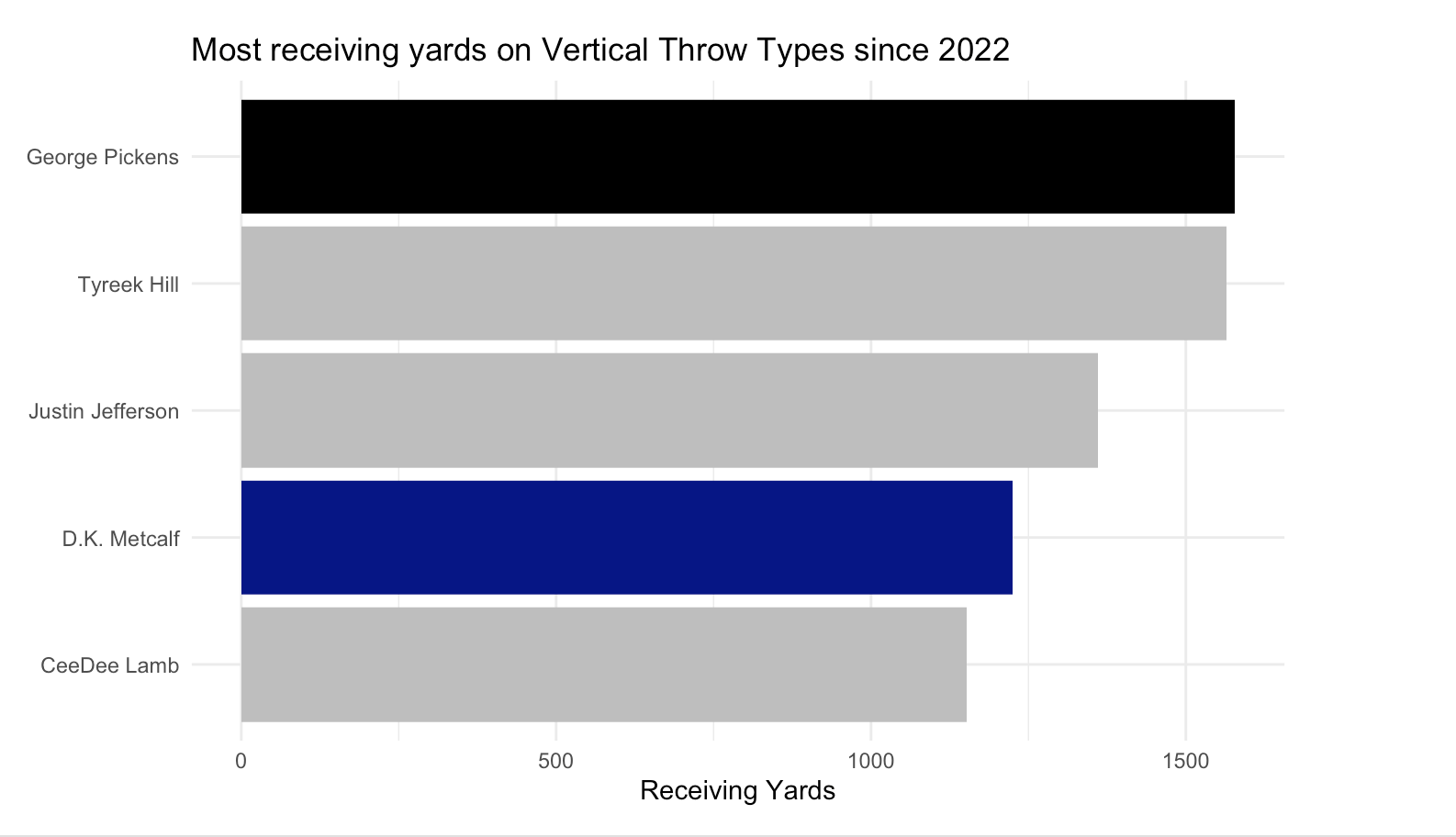- Rodgers may be the Steelers' best quarterback option in nearly a decade: Although the 41-year-old is no longer an annual MVP candidate, his play-action success and vertical tendencies could bring new life to Pittsburgh's offense.
- Much could stay the same from 2024: The Steelers are poised to continue with a run-heavy approach and pass-game success that stems from vertical shots to their top two receivers.
- Subscribe to PFF+: Get access to player grades, PFF Premium Stats, fantasy football rankings, all of the PFF fantasy draft research tools and more!
Estimated Reading Time: 8 minutes

The waiting game has ended in Pittsburgh, with Aaron Rodgers signing a one-year, $13.6 million contract.
Rodgers projects to be the fifth starting quarterback to start the season opener for the Pittsburgh Steelers in as many years, following Ben Roethlisberger in 2021, Mitchell Trubisky in 2022, Kenny Pickett in 2023 and Justin Fields last year.
The bar for Rodgers to be an improvement behind center in Pittsburgh is low. The last time a Steelers quarterback earned a PFF overall grade higher than 80.0 was in 2017 (Roethlisberger).

Even when Pittsburgh has had a quarterback finish with a PFF overall grade above the median at the position since Roethlisberger’s decline — Trubisky and Pickett in 2022 and Wilson in 2024 — the offense still finished in the bottom half of the NFL in expected points added (EPA) per dropback. The big picture tells a similar story: The Steelers rank 24th in EPA per dropback and 26th in success rate in the passing game since 2019.
That has been enough to get the Steelers into the playoff picture or the wild-card round, but not enough to push them to a playoff victory, something they last accomplished in the 2016 postseason.
By signing Rodgers, Pittsburgh is signaling that its contention window remains open in 2025, rather than it being a lost year with the goal of securing an early 2026 NFL Draft pick and finding a franchise quarterback.
Now the question becomes how serious a contender the Steelers can actually be with a 41-year-old Rodgers.
Much of that answer revolves around the offensive supporting cast and how well Rodgers and offensive coordinator Arthur Smith mesh.
There should be some overlap between Smith’s offense and the Matt LaFleur offense that Rodgers won two MVPs in during the 2020 and 2021 seasons. Smith was a tight ends coach for the Tennessee Titans under LaFleur (offensive coordinator) in 2018 before LaFleur went to Green Bay and Smith replaced him as Tennessee's offensive coordinator.
After taking the Packers’ head coach position in 2019, LaFleur said of Smith, “Of course I would have loved to have had him here. But I knew there was no way he was going to get out of that building.”
It might have taken a season for things to fully click, but the marriage between Rodgers and LaFleur undoubtedly led to the veteran's career resurgence.
Packers’ EPA per Dropback Rank by Season | 2019-2022
| Season | EPA per Dropback Rank |
| 2019 | 10th |
| 2020 | 1st (Rodgers MVP) |
| 2021 | 3rd (Rodgers MVP) |
| 2022 | 16th |
So it’s worth investigating what led to Rodgers’ success in that stint with LaFleur, and if any of that magic can be captured in Smith’s offense four years after Rodgers' last MVP season.
One of the first things that jumps out is that Rodgers began getting the ball out quicker during the 2020 season. That’s not overly surprising; older quarterbacks typically average less time to throw toward the end of their careers. They don’t have the same level of athleticism to extend plays and buy time for their receivers to create separation.

Rodgers wasn’t just getting the ball out quickly, though. He also found success when doing so.
The only two teams in the NFL with a higher EPA per play than the Packers when throwing the ball in 2.5 seconds or less across Rodgers’ four seasons with LaFleur were the Kansas City Chiefs and San Francisco 49ers.
Rodgers’ time to throw with the Jets last season sat in a similar range, at 2.68 seconds, and he was once again at his best when getting the ball out quickly.

Wilson (with the Steelers) and Rodgers (with the Jets) both graded out as top-five passers in the NFL last season when getting the ball out in 2.5 seconds or less. They’re highlighted by the black and green dots, respectively, in the plot above. As you can see, Rodgers also got rid of the ball in 2.5 seconds or less at one of the highest rates in the league.
When quarterbacks are getting the ball out that quickly, they’re typically not testing defenses downfield. But that’s not necessarily the case on vertical shots down the sideline that develop quickly — an area that both Rodgers and Wilson have been among the best in throughout their NFL careers.
PFF charts pass types, bucketing attempts into types of passes based on the quarterback’s intent. If we combine three of those — vertical lead (vertical throw trying to lead the receiver), over the shoulder (pass thrown over the shoulder of the wide receiver) and vertical back shoulder (vertical throw to back shoulder) — we can capture how often and how effectively a quarterback takes vertical shots.
Across Rodgers’ four seasons with LaFleur, only Tom Brady had more of those pass attempts than Rodgers.
Most Pass Attempts with Vertical Throw Type | 2019-2022 Seasons
| Quarterback | Vertical Passing Attempts | Vertical PFF Passing Grade |
| Tom Brady | 458 | 95.8 (2nd) |
| Aaron Rodgers | 409 | 96.2 (1st) |
| Russell Wilson | 367 | 92.3 (8th) |
| Derek Carr | 350 | 93.5 (6th) |
| Josh Allen | 342 | 87.1 (17th) |
This isn’t something that dissipated with the Jets, either. Rodgers was the only quarterback in the NFL with more than 100 pass attempts on those vertical throw types during the 2024 season (103).
A significant chunk of Russell Wilson’s success in Arthur Smith’s offense last year stemmed from those plays. He racked up 38% of his passing yards on those vertical throw types — more than 5 percentage points higher than the next closest quarterback.
Some of that production came with Calvin Austin III on the receiving end, but a bulk of it came when targeting George Pickens, who was traded this offseason to the Dallas Cowboys. Pickens’ 1,578 receiving yards on those three vertical throw types lead the NFL since he was drafted in 2022.
The Steelers may no longer have Pickens, but they replaced him with another player in the top five of that metric, acquiring D.K. Metcalf from the Seattle Seahawks.

Metcalf entered the NFL with a fairly limited route tree, and while he has rounded that out some, those vertical routes are still where he shines. In that respect, he should offset Pickens' departure and quickly become Rodgers’ top downfield target in Pittsburgh.
Rodgers has always preferred to operate outside the numbers, similar to Wilson. His percentage of throws between the numbers in four seasons with LaFleur (41%) sits 5 percentage points lower than Jordan Love’s in the two seasons since (46%).
Smith has shown a willingness to adapt his offense to his quarterback, so there will likely be a healthy dose of those sideline shots that Pittsburgh had success with in 2024 and that play to Rodgers’ and Metcalf’s strengths.
The other area where Rodgers excelled with LaFleur in Green Bay — and that has been a staple of Arthur Smith’s offenses — is play action. Before Smith's arrival, Pittsburgh was consistently at the bottom of the NFL in play-action usage, much to the chagrin of Steelers fans.
Steelers' Play-Action Rate by Season | 2020-24
| Year | Play-Action Rate | Rank |
| 2020 | 10.2% | 32nd |
| 2021 | 19.0% | 30th |
| 2022 | 18.8% | 27th |
| 2023 | 15.2% | 31st |
| 2024 | 27.6% | 11th |
That bump of 10 percentage points is unsurprising, given Smith’s track record at multiple stops since becoming an offensive play caller. The Titans ranked second in play-action usage across the 2019 and 2020 seasons (33.4%), and the Falcons also ranked second (33.4%) in his three seasons as head coach.
By the end of Mike McCarthy’s tenure in Green Bay, Rodgers (much like Roethlisberger toward the end of his career in Pittsburgh) preferred a static offense where he could sit in shotgun and make adjustments at the line of scrimmage. The early stage of the Rodgers-LaFleur pairing in Green Bay was largely about finding a middle ground between LaFleur’s scheme and Rodgers' preferences at that point.
The Packers’ play-action rate in the season before LaFleur stepped in as head coach in 2018 was just 18.4% (fifth lowest in the NFL). Over the next four seasons, that rose to 26.9% (15th in NFL), and the Packers’ EPA per play when using play action (0.376) was significantly higher than any other offense in the NFL across Rodgers’ two MVP seasons in 2020 and 2021.
Play action is one of the more notable areas where Pittsburgh’s offense underperformed last season, with the unit ranking in the bottom five in success rate off play action, which measures the percentage of plays generating positive EPA. The hope is that Smith can help Rodgers excel off play action, similar to when he was at his best with LaFleur in Green Bay.
The Steelers' offense may also be molded to Rodgers' strength with quick passes to the flat. That has consistently been an area where Rodgers has been among the league leaders, and Pittsburgh will likely call more such plays in 2025.
Rodgers led the NFL in the combination of screen and bubble passes both in the stretch from 2019 to 2022 with LaFleur (155) and last season with the Jets (50). As a team, Pittsburgh had just 27 such attempts last season (22nd in NFL).
The yards-after-catch ability necessary for success on these plays is one of the bigger areas of weakness in Pittsburgh’s current receiving corps.
Percentile in Yards After the Catch per Reception Among Wide Receivers | Since 2022
| Wide Receiver | YAC/Rec. Percentile |
| D.K. Metcalf | 37th |
| Calvin Austin III | 44th |
| Robert Woods | 17th |
A healthy Roman Wilson, who played just five offensive snaps as a rookie last year, may be able to help in that regard, but that’s far from a sure thing.
The reality is that success for Pittsburgh's offense is largely going to be built similarly to the 2024 unit: a run-heavy approach with pass-game success that stems from vertical shots to the top two receivers (Metcalf and Austin).
The run game could be better, considering the addition of rookie Kaleb Johnson, who thrived on zone runs at Iowa and theoretically fits Arthur Smith’s scheme, and the improvement expected from young offensive linemen Zach Frazier and Mason McCormick, who showed promise as rookies in 2024. But the Steelers are also counting on two tackles — Troy Fautanu (one week played as a rookie before injury) and Broderick Jones (PFF grades below 60.0 in each of his first two seasons) — who are relative unknowns at this stage.
What we saw from Rodgers at the back half of the 2024 season, further removed from his Achilles injury and past his early-season ankle/hamstring issues, was a quarterback who can be the Steelers’ best option at the position in nearly a decade. But he’s still a 41-year-old who can’t be counted on to be the team's savior.
A strong run game, an improved young offensive line and another addition to the receiving corps — Pittsburgh has been linked to complementary pass-game pieces Jonnu Smith and Gabe Davis — are the best chances for the Steelers to maximize a short contention window before they turn the page and look for their quarterback of the future.



 © 2025 PFF - all rights reserved.
© 2025 PFF - all rights reserved.